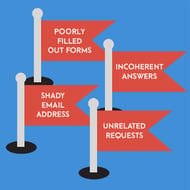
When you begin inbound marketing, your primary goal is to generate leads. Yet another, and more paramount pillar of inbound marketing, is to generate qualified inbound leads. In other words, your real goal is to collect contact information from contacts who are genuinely interested and likely to use your business.
The way you'd approach a window shopper versus someone highly interested in your product should be very different. Both leads are at different stages of the buyer’s journey and have different needs.
The same theory is used in inbound marketing. How can you tell which lead is more likely to convert to a sale? The answer is lead scoring.
Lead Scoring 101
Lead scoring is exactly like it sounds. You assign value (a score) to generated leads to identify which ones have the most potential to convert into sales. Usually, it’s a numeric value from zero to 100. The higher the value, the more likely it is that a lead will make a purchase.
Lead scoring values can be based on any number of attributes, including how a user interacts with your website, how much information she provides, or the products she’s interested in. Once you score your leads, your sales and marketing team will have a better idea of whom to target and how to respond.
The Benefits of Lead Scoring
The most obvious benefit of lead scoring is the ability to focus your energy on leads that will actually pay off. Nothing wastes money more than spending time on leads that won’t convert. If you know statistically which leads have a better chance of turning into sales, you can spend your time (and money) more effectively.
Over two-thirds of highly effective marketing experts claim that lead scoring is one of their top revenue contributors. Businesses that use lead scoring see 77% higher lead generation ROI compared to businesses that don’t.
The main point: lead scoring helps your sales and marketing team be more effective at converting leads into sales in a shorter amount of time. Less time and effort to generate more sales is a big win for any business.
Identify Opportunities with Existing Customers
Lead scoring applies to more than just new customers. You can also use it to resell, upsell, or cross-sell to existing customers. This can be an extremely powerful sales tool because selling to existing customers has a 60 to 70% success rate, while new customers have only a 5 to 20% success rate.
If you notice an existing customer start to generate a lead score again, it might be time for the sales team to reach out. Existing customers are much more likely to purchase a product than a new customer, so you have a better shot at making another sale.
How to Create a Lead Scoring System
No two businesses will score their leads the same way. For example, if you sell luxury yachts, someone in the 18-25 age demographic probably won’t score as high as someone in an older demographic. But for a mobile game developer, that score would be flipped. That’s why every business should create a unique lead scoring system.
Creating this system might seem like a daunting task, but luckily, you already have a head start. All you need to do is look at your past leads and customers.
Your past leads and sales will tell you everything you need to know to create a powerful lead scoring system. Examine the various attributes and demographics of your past leads, compare the data to sales statistics, and look for correlations.
If customers with a specific attribute make more purchases, then that attribute should score higher than others.
Don’t Forget to Consult Your Sales Team
Numbers and analytics are great, but they don’t always paint a complete picture. When you look for attributes to create your scoring system, talk to your sales team. They’re the ones on the ground interacting with customers. They know your buyer's pain points and journey better than anyone, and can provide you with helpful insights that analytics won't show.
Lead Scoring Models
There are countless ways for businesses to score leads. To make the process a bit simpler, here are six lead scoring models on which to base your system. Pick and choose the pieces you like in order to create a unique lead scoring method that works for your business.
Customer Demographics

If you notice that most of your previous customers fall into a certain age or socio-economic range, demographics might be an important scoring attribute. When looking at previous data, consider any defining demographic that might impact sales rates:
- Age
- Gender
- Income
- Education
- Location
- Employment
If you identify any correlations, you might want to include demographic questions on your online forms. For example, you might not be able to offer services outside of your city. Asking leads where they’re located will identify higher-ranking leads. Someone who lives outside of your service area might score negative points, while someone closer to your headquarters will earn the maximum number of points.
Of course, asking for too much or sensitive demographic information can turn people away. Choose your demographic questions carefully.
Online Behavior
How a potential customer interacts with your website can tell you a lot about his or her buying habits. For example, if you notice that most customers download a specific eBook before making a purchase, make that a scoring factor. You could make it even simpler by ranking webpage views. A user who visits 20 webpages is probably more interested in your products or services than someone who visits only two.
The inverse is also true. If an existing customer stops looking at webpages altogether, they’re likely not interested anymore. It might be a good idea to take points away after a certain period without any online activity.
Spam Red Flags
Negative points are just as important as positive points. If a lead continues to show signs that he won’t be a good customer, you don’t want to waste time selling to him. Look for red flags that might indicate a customer isn’t really interested or doesn’t care about your products or services:

- Poorly filled out forms
- Incoherent answers
- Shady email addresses
- Requests unrelated to your services
You might also want to assign negative points to legitimate leads that aren’t right for your business. For example, if you’re a B2B business, someone using a Gmail email address probably isn’t the type of lead you’re looking for. Assign them some negative points and move on to more promising leads.
The Final Talley
An effective scoring system will help you identify which leads have a better chance of becoming sales. Create a unique scoring system suited to your business and this essential information will help your sales and marketing team to use its time, energy, and resources more effectively and result in a significant ROI boost.


